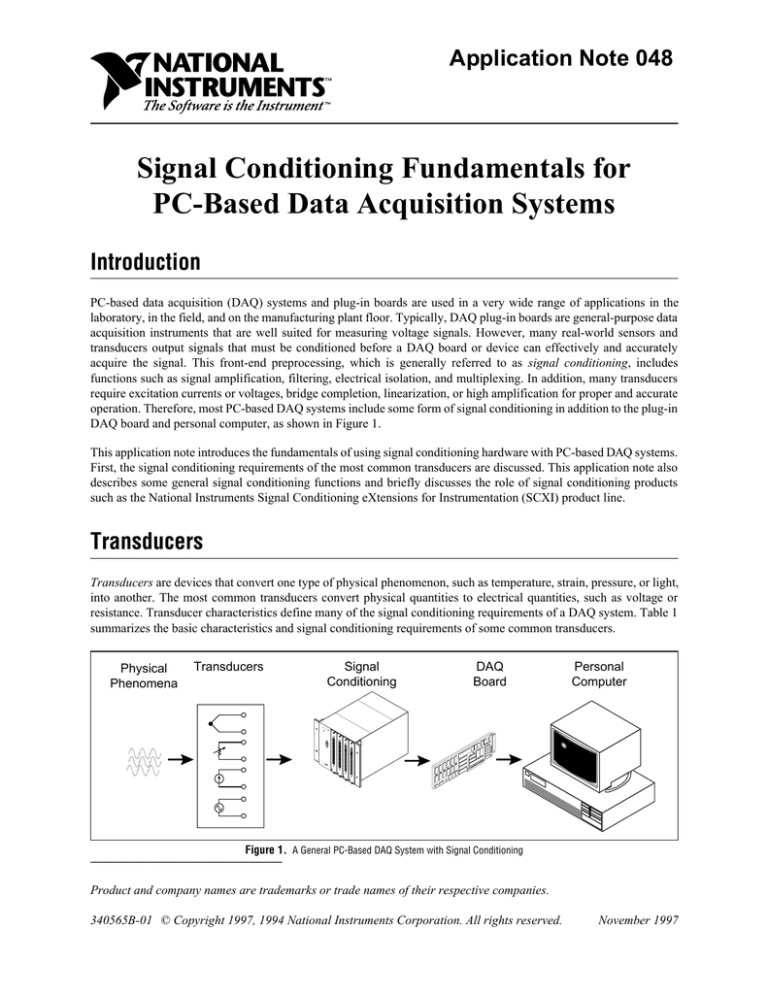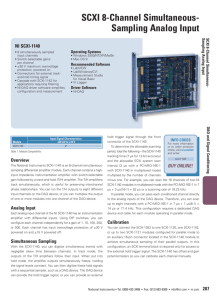Signal Conditioning Fundamentals for PC
advertisement

Application Note 048 Signal Conditioning Fundamentals for PC-Based Data Acquisition Systems Introduction PC-based data acquisition (DAQ) systems and plug-in boards are used in a very wide range of applications in the laboratory, in the field, and on the manufacturing plant floor. Typically, DAQ plug-in boards are general-purpose data acquisition instruments that are well suited for measuring voltage signals. However, many real-world sensors and transducers output signals that must be conditioned before a DAQ board or device can effectively and accurately acquire the signal. This front-end preprocessing, which is generally referred to as signal conditioning, includes functions such as signal amplification, filtering, electrical isolation, and multiplexing. In addition, many transducers require excitation currents or voltages, bridge completion, linearization, or high amplification for proper and accurate operation. Therefore, most PC-based DAQ systems include some form of signal conditioning in addition to the plug-in DAQ board and personal computer, as shown in Figure 1. This application note introduces the fundamentals of using signal conditioning hardware with PC-based DAQ systems. First, the signal conditioning requirements of the most common transducers are discussed. This application note also describes some general signal conditioning functions and briefly discusses the role of signal conditioning products such as the National Instruments Signal Conditioning eXtensions for Instrumentation (SCXI) product line. Transducers Transducers are devices that convert one type of physical phenomenon, such as temperature, strain, pressure, or light, into another. The most common transducers convert physical quantities to electrical quantities, such as voltage or resistance. Transducer characteristics define many of the signal conditioning requirements of a DAQ system. Table 1 summarizes the basic characteristics and signal conditioning requirements of some common transducers. Physical Phenomena Transducers Signal Conditioning DAQ Board Personal Computer SC XI- 10 01 SCXI 1140 SCXI 1140 SCXI 1140 SCXI 1140 SC XI MAIN FRAM E Figure 1. A General PC-Based DAQ System with Signal Conditioning ————————————————— Product and company names are trademarks or trade names of their respective companies. 340565B-01 © Copyright 1997, 1994 National Instruments Corporation. All rights reserved. November 1997 Table 1. Electrical Characteristics and Basic Signal Conditioning Requirements of Common Transducers Sensor Electrical Characteristics Signal Conditioning Requirements Thermocouple Low-voltage output Low sensitivity Nonlinear output Reference temperature sensor (for cold-junction compensation) High amplification Linearization RTD Low resistance (100 ¾ typical) Low sensitivity Nonlinear output Current excitation Four-wire/three-wire configuration Linearization Strain gauge Low-resistance device Low sensitivity Nonlinear output Voltage or current excitation Bridge completion Linearization Current-output device Current loop output (4-20 mA typical) Precision resistor Thermistor Resistive device High resistance and sensitivity Very nonlinear output Current excitation or voltage excitation with reference resistor Linearization Integrated circuit (IC) temperature sensor High-level voltage or current output Linear output Power source Moderate gain The following sections describe thermocouples, resistive-temperature detectors (RTDs), strain gauges, and currentoutput devices. Thermocouples The most popular transducer for measuring temperature is the thermocouple. Because the thermocouple is inexpensive, rugged, and can operate over a very wide range of temperatures, the thermocouple is a very versatile and useful sensor. However, the thermocouple has some unique signal conditioning requirements. A thermocouple operates on the principle that the junction of two dissimilar metals generates a voltage that varies with temperature. However, measuring this voltage is difficult because connecting the thermocouple to DAQ board measurement wires creates what is called the reference junction or cold junction, shown in Figure 2. These additional junctions act as thermocouples themselves and produce their own voltages. Thus, the final measured voltage, VMEAS, includes both the thermocouple and reference-junction voltages. The method of compensating for these unwanted reference-junction voltages is called cold-junction compensation. There are two general approaches to cold-junction compensation – hardware and software compensation. Hardware compensation uses a special circuit that applies the appropriate voltage to cancel the cold-junction voltage. Although you need no software for hardware compensation, each thermocouple type must have its own compensation circuit that works at all ambient temperatures, which can be expensive. 2 Reference Junction – Thermocouple – V1 V2 + + DAQ Board + VMEAS – Copper Leads Figure 2. A Thermocouple Connected to a DAQ Board Software cold-junction compensation, on the other hand, is very flexible and requires only knowing the ambient temperature. If you use an additional sensor to directly measure the ambient temperature at the cold junction, software can compute the appropriate compensation for the unwanted thermoelectric voltages. This is why many signal conditioning accessories are equipped with direct-reading temperature sensors, such as thermistors or semiconductor sensors, installed at the terminals. Software cold-junction compensation follows this process: 1. Measure the temperature of the reference junction and compute the equivalent thermocouple voltage for this junction using standard thermocouple tables or polynomials. 2. Measure the output voltage (VMEAS) and add – not subtract – the reference-junction voltage computed in step 1. 3. Convert the resulting voltage to temperature using standard thermocouple polynomials or look-up tables. Many software packages, such as LabVIEW™, LabWindows™, and NI-DAQ™, include routines that perform these temperature-to-voltage and voltage-to-temperature conversions for different types of thermocouples according to National Institute of Standards and Technology (NIST) standard reference tables. Sensitivity is another characteristic to consider with thermocouple measurements. Thermocouple outputs are very low level and change only 7 to 50 µV for every 1° C change in temperature. You can increase the sensitivity of the system with a low-noise, high-gain amplification of the signal. For example, a plug-in DAQ board with an analog input range of ±5 V, an amplifier gain of 100, and a 12-bit analog-to-digital converter (ADC) has the following resolution: 10 V (2 )100 12 = 24. 4 µV bit However, the same DAQ board with a signal conditioner amplifier gain of 1,000 has a resolution of 2.4 µV/bit, which corresponds to a fraction of a degree Celsius. More importantly, an external signal conditioner can amplify the low-level thermocouple signal close to the source, which minimizes noise corruption. A high-level amplified signal suffers much less corruption from radiated noise in the environment and in the PC than a low-level unamplified signal. 3 RTDs Another popular temperature-sensing device is the RTD, which is known for its stability and accuracy over a wide temperature range. An RTD consists of a wire coil or deposited film of pure metal whose resistance increases with temperature. Although RTDs constructed with different metals and resistance are available, the most popular type of RTD is made of platinum and has a nominal resistance of 100 ¾ at 0° C. Because an RTD is a passive resistive device, you must pass a current through the RTD to produce a voltage that a DAQ board can measure. RTDs have relatively low resistance (100 ¾) that changes only slightly with temperature (less than 0.4 ¾/°C), so you might need to use special configurations that minimize errors from lead wire resistance. For example, consider the measurement of a two-wire RTD in Figure 3. With this RTD, labeled RT, the voltage drops caused by the excitation current, IEXC, passing through the lead resistances, RL, add to the measured voltage, VO. IEXC RL RT + VO – RL Figure 3. A Two-Wire RTD For longer lead lengths, therefore, the four-wire RTD in Figure 4 is a better choice. With a four-wire RTD, one pair of wires carries the excitation current through the RTD; the other pair senses the voltage across the RTD. Because only negligible current flows through the sensing wires, the lead resistance error is very small. IEXC RL RL RT RL + VO – RL Figure 4. A Four-Wire RTD To keep costs down, RTDs are also available in three-wire configurations. The three-wire RTD is most effective in a Wheatstone bridge configuration (see the following Strain Gauges section). In this configuration, the lead resistances are located in opposite arms of the bridge, so their errors cancel each other out. 4 Strain Gauges The strain gauge is the most common device used in mechanical testing and measurements. The most common type is the bonded-resistance strain gauge, which consists of a grid of very fine foil or wire. The electrical resistance of the grid varies linearly with the strain applied to the device. When using a strain gauge, you bond the strain gauge to the device under test, apply force, and measure the strain by detecting changes in resistance. Strain gauges are also used in sensors that detect force or other derived quantities, such as acceleration, pressure, and vibration. These sensors generally contain a pressure-sensitive diaphragm with strain gauges mounted to the diaphragm. Because strain measurement requires detecting relatively small changes in resistance, the Wheatstone bridge circuit is almost always used. The Wheatstone bridge circuit consists of four resistive elements with a voltage excitation supply applied to the ends of the bridge. Strain gauges can occupy one, two, or four arms of the bridge, with any remaining positions filled with fixed resistors. Figure 5 shows a configuration with a half-bridge strain gauge consisting of two strain elements, RG1 and RG2, combined with two fixed resistors, R1 and R2. VEXC R1 RG1 – VO R2 + RG2 Figure 5. Half-Bridge Strain Gauge Configuration With a voltage, VEXC, powering the bridge, the DAQ system measures the voltage across the bridge: VO = R2 RG 2 VEXC − RG1 + R G2 R 1 + R2 When the ratio of RG1 to RG2 equals the ratio of R1 to R2, the measured voltage VO is 0 V. This condition is referred to as a balanced bridge. As strain is applied to the gauges, their resistance values change, causing a change in the voltage at VO. Full-bridge and half-bridge strain gauges are designed for maximum sensitivity by arranging the strain gauge elements in opposing directions. For example, the half-bridge strain gauge in Figure 5 includes an element RG1, which is installed so that its resistance increases with positive strain, and an element RG2, whose resistance decreases with positive strain. The resulting VO responds with a sensitivity that is twice that of a quarter-bridge configuration. Some signal conditioning products have voltage excitation sources, as well as provisions for bridge-completion resistors. Bridge completion resistors should be very precise and stable. Because strain-gauge bridges are rarely perfectly balanced, some signal conditioners also null offsets, a process in which you adjust the resistance ratio of the unstrained bridge to balance the bridge and remove any initial DC offset voltage. Alternatively, you can measure this initial offset voltage and use this measurement in your conversion routines to compensate for the unbalanced initial condition. 5 Current Signals Many sensors that are used in process control and monitoring applications output a current signal, usually 4 to 20 mA or 0 to 20 mA. Current signals are sometimes used because they are less sensitive to errors such as radiated noise and lead resistance voltage drops. Signal conditioners must convert this current signal to a voltage signal. To do this easily, pass the current signal through a resistor, as shown in Figure 6. Current-Output Device + VO = IS R – IS R Figure 6. Current Signals and Signal Conditioning You can then use a DAQ system to measure the voltage VO = ISR that will be generated across the resistor, where IS is the current and R is the resistance. Select the resistor value that has a usable range of voltages, and use a high-precision resistor with a low temperature coefficient. For example, the SCXI Process-Current Resistor Kit consists of 249 ¾, 0.1%, 5 ppm/°C resistors. These resistor values will convert a 4 to 20 mA current loop into a voltage signal that varies from 0.996 to 4.98 V. General Signal Conditioning Functions Regardless of the types of sensors or transducers you are using, the proper signal conditioning equipment can improve the quality and performance of your system. Signal conditioning functions are useful for all types of signals, including amplification, filtering, and isolation. Amplification Unwanted noise can play havoc with the measurement accuracy of a PC-based DAQ system. The effects of system noise on your measurements can be extreme if you are not careful. Signal conditioning circuitry with amplification, which applies gain outside of the PC chassis and near the signal source, can increase measurement resolution and effectively reduce the effects of noise. An amplifier, whether located directly on the DAQ board or in external signal conditioners, can apply gain to the small signal before the ADC converts the signal to a digital value. Boosting the input signal uses as much of the ADC input range as possible. However, many transducers produce voltage output signals on the order of millivolts or even microvolts. Amplifying these low-level analog signals directly on the DAQ board also amplifies any noise picked up from the signal lead wires or from within the computer chassis. When the input signal is as small as microvolts, this noise can drown out the signal itself, leading to meaningless data. A simple method for reducing the effects of system noise on your signal is to amplify the signal as close to the source as possible, which boosts the analog signal above the noise level before noise in the lead wires or computer chassis can corrupt the signal. For example, a J-type thermocouple outputs a very low-level voltage signal that varies by about 50 µV/°C. Suppose that the thermocouple leads must travel 10 m through an electrically noisy plant environment to the DAQ system. If the various noise sources in the environment couple 200 µV onto the thermocouple leads, you obtain a noisy temperature reading with about 4° C of noise. However, amplifying the signal close to the thermocouple before noise corrupts the signal alleviates this problem. Amplifying the signal with a gain of 500 with a signal conditioner placed near the thermocouple produces a thermocouple signal that varies by about 25 mV/°C. As this high-level signal travels the same 6 10 m, the 200 µV of noise coupled onto this signal after amplification has much less of an effect on the final measurement, adding only a fraction of a degree Celsius of noise to the measured temperature reading. Filtering and Averaging You can also use filters to reject unwanted noise within a certain frequency range. Many systems will exhibit 60 Hz periodic noise components from sources such as power supplies or machinery. Lowpass filters on your signal conditioning circuitry can eliminate unwanted high-frequency components. However, be sure to select the filter bandwidth carefully so that you do not affect the time response of your signals. Although many signal conditioners include lowpass noise filters to remove unwanted noise, an extra precaution is to use software averaging to remove additional noise. Software averaging is a simple and effective technique of digitally filtering acquired readings; for every data point you need, the DAQ system acquires and averages many voltage readings. For example, a common approach is to acquire 100 points and average those points for each measurement you need. For slower applications in which you can oversample in this way, averaging is a very effective noise filtering technique. Isolation Improper grounding of the DAQ system is the most common cause of measurement problems and damaged DAQ boards. Isolated signal conditioners can prevent most of these problems by passing the signal from its source to the measurement device without a galvanic or physical connection. Isolation breaks ground loops, rejects high common-mode voltages, and protects expensive DAQ instrumentation. Common methods for circuit isolation include using optical, magnetic, or capacitive isolators. Magnetic and capacitive isolators modulate the signal to convert it from a voltage to a frequency. The frequency can then be transmitted across a transformer or capacitor without a direct physical connection before being converted back to a voltage value. When you connect your sensor or equipment ground to your DAQ system, you will see any potential difference in the grounds on both inputs to your DAQ system. This voltage is referred to as common-mode voltage. If you are using a single-ended measurement system, as shown in Figure 7, the measured voltage includes the voltage from the desired signal, VS, as well as this common-mode voltage from the additional ground currents in the system, VG. + + + – VS + VS – ∆VG Grounded Signal Source + – – Single-Ended Measurement System ∆VG VM – VM = VS +∆ VG Measurement System Ground Source Ground Figure 7. Single-Ended DAQ Measurement System If you are using a DAQ board with differential inputs, you can reject some of this common-mode voltage, typically up to 12 V. However, larger ground potential differences, or ground loops, will damage unprotected DAQ devices. If you cannot remove the ground references, use isolating signal conditioners that break these ground loops and reject very 7 large common-mode voltages. For example, SCXI isolation amplifier modules can operate with up to 250 Vrms of common-mode voltage. This isolation rating is for safe working voltage and is CE compliant. Isolators also provide an important safety function by protecting against high-voltage surges from sources like power lines, lightning, or high-voltage equipment. When dealing with high voltages, a surge can damage the equipment or even harm equipment operators. By breaking the galvanic connection, isolated signal conditioners produce an effective barrier between the DAQ system and these high-voltage surges. Multiplexing Signal conditioners equipped with signal multiplexers can cost-effectively expand the input/output (I/O) capabilities of your plug-in DAQ board. The typical plug-in DAQ board has 8 to 16 analog inputs and 8 to 24 digital I/O lines. External multiplexers can increase the I/O capacity of a plug-in board to hundreds and even thousands of channels. Analog input multiplexers use solid-state or relay switches to sequentially switch, or scan, multiple analog input signals onto a single channel of the DAQ board. For higher speed applications, be sure that the multiplexing circuit, as well as the DAQ board, can operate at the needed scanning rates. Digital Signal Conditioning Digital signals can also require signal conditioning peripherals. Usually, you should not directly connect digital signals used in research and industrial environments to a DAQ board without some type of isolation because of the possibility of large voltage spikes or large common-mode voltages. Some signal conditioning modules and boards optically isolate the digital I/O signals to remove these problems. Digital I/O signals can control electromechanical or solid-state relays to switch loads such as solenoids, lights, motors, and so on. You can also use solid-state relays to sense high-voltage field signals and convert them to digital signals. Signal Conditioning Systems for PC-Based DAQ Systems The signal conditioning functions discussed in this application note are implemented in different types of signal conditioning products. These products cover a very wide range of price and capability. For example, the National Instruments SC-207X Series termination boards have a temperature sensor for use with thermocouples and a breadboard area with silkscreened component locations for easy addition of current measurement resistors, simple resistance-capacitance (RC) filters, and other signal conditioning circuitry. The 5B Series of signal conditioning I/O modules is for specific types of transducers or signals. You can install up to 16 I/O modules in a backplane and directly connect the modules to a plug-in DAQ board. For external signal multiplexing, the AMUX-64T analog multiplexer board expands the analog input capability of your I/O multifunction board to up to 256 channels. The AMUX-64T also includes a temperature sensor and silkscreened component locations. The SCXI product line is a signal conditioning system that combines the expandability of multiplexing with the flexibility of modular signal conditioning. Signal Conditioning with SCXI SCXI is a signal conditioning and instrumentation front end for plug-in DAQ boards. An SCXI system consists of an SCXI chassis that houses one or more signal conditioning modules that multiplex, amplify, isolate, and condition both analog and digital signals. The SCXI system then passes the conditioned signals to a single plug-in DAQ board for acquisition directly into the PC, as shown in Figure 8. 8 A variety of SCXI modules are available with different signal conditioning capabilities. For example, the SCXI-1120 module is an eight-channel isolation amplifier module. Each of the input channels includes an isolation amplifier with gains of up to 2,000 and a lowpass filter configurable for gains of 4 Hz or 10 kHz. The SCXI-1121 module is a four-channel isolation amplifier module that also has four channels of excitation. You can configure each excitation channel for voltage or current. The module also includes half-bridge completion circuitry for strain-gauge measurements. Terminal blocks for the SCXI modules include temperature sensors for cold-junction compensation with thermocouples. The SCC Series is a modular portable signal conditioning system. SCC consists of single and dual-channel signal conditioning modules with built-in signal connectors. For example, the SCC-TC02 provides amplification, filtering, cold-junction compensation, and a convenient miniplug connector for one thermocouple input. You install any combination of SCC modules onto an SCC carrier or backplane, such as the SC-2345. The SC-2345 holds up to 18 SCC modules and cables directly to an E Series DAQ board or module. Conclusion Signal conditioning is an important component of a complete PC-based DAQ system. Signal conditioning has many features that you can use to connect sensors such as thermocouples, RTDs, strain gauges, and current-output devices to PC-based DAQ boards. No matter what sensors you are using, signal conditioning can improve the accuracy, effectiveness, and safety of your measurements because of capabilities such as amplification, isolation, and filtering. The National Instruments SCXI product line can supply the signal conditioning and instrumentation front end you need for your PC-based DAQ systems. d anals d n e fi ig plid S m e t A la Iso is ss a Ch I CX S SC XI- 10 01 SCX I 1140 SCX I 1140 SCX I 1140 SCX I 1140 SCX I 1140 SCX I 1140 SCX I 1140 SCX I 1140 SC MAIN SCX XI FRAM I 1140 E SCX I 1140 SCX I XIal SC in rmcks e T lo B XI SCdule Mo 1140 ta n Daisitio qu rd AcBoa SCX I 1140 SC XI 110 0 d anrs s l e a c gn u Siansd Tr d rreory e f ns m ra Me T ta y to Daectl r Di Figure 8. A PC-Based DAQ System with SCXI 9


